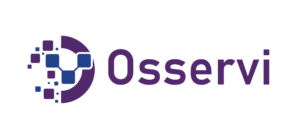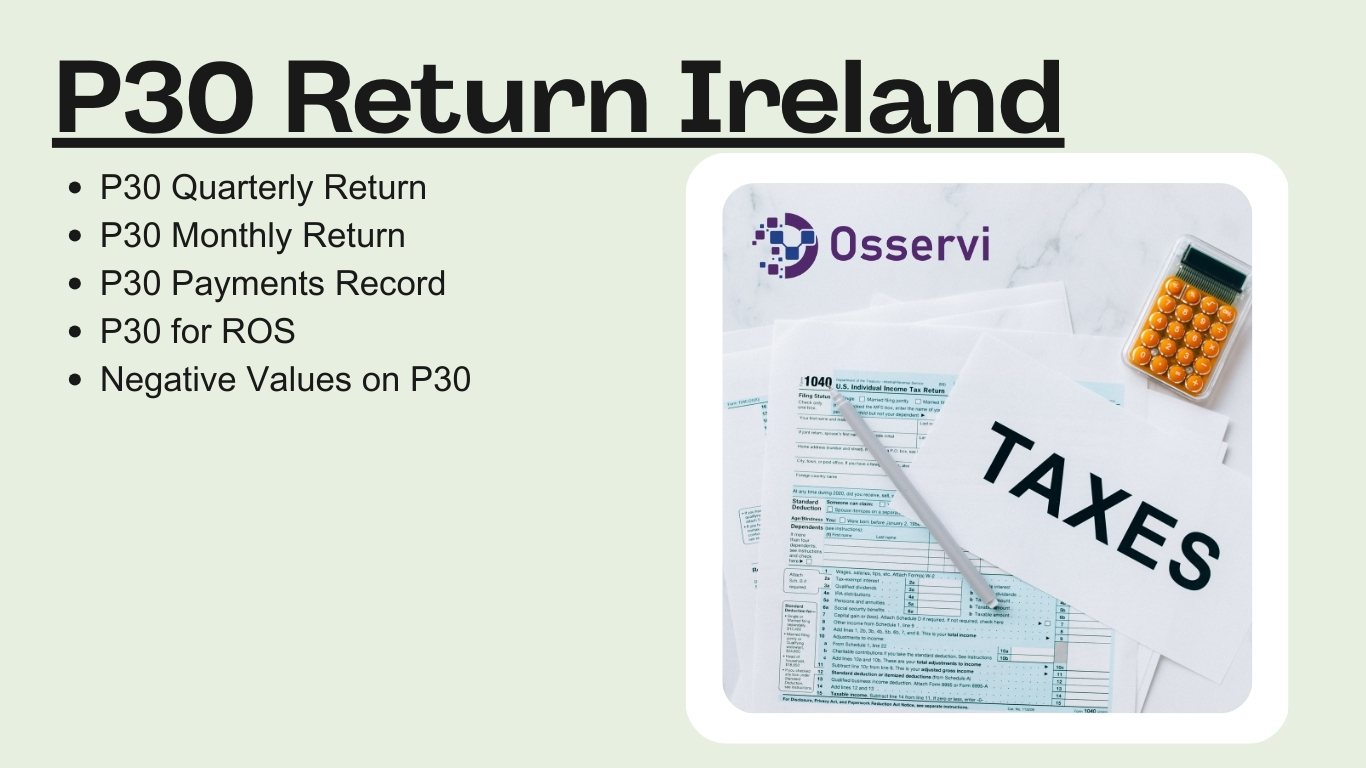Navigating tax obligations is an essential aspect of running a business, and in Ireland, the P30 Monthly Return is a vital component of the tax landscape. Understanding and fulfilling your P30 obligations ensures compliance with Irish tax law and contributes to the smooth operation of your business. In this comprehensive guide, we’ll delve into what the P30 Monthly Return entails, why it’s important, and how to fulfill it effectively.
What is the P30 Monthly Return? The P30 Monthly Return is a tax document that businesses in Ireland use to report and pay their Pay As You Earn (PAYE), Universal Social Charge (USC), and Local Property Tax (LPT) liabilities to the Revenue Commissioners on a monthly basis. It is a crucial part of fulfilling your tax obligations as an employer.
Why is the P30 Monthly Return Important?
- Legal Compliance: Compliance with tax laws is mandatory for all businesses operating in Ireland. Failure to comply with P30 obligations can result in penalties, fines, or legal action.
- Funding Public Services: The taxes collected through the P30 Monthly Return contribute to funding public services such as healthcare, education, and infrastructure, benefiting society as a whole.
- Avoiding Interest and Penalties: Timely submission and payment of P30 obligations help businesses avoid accruing interest and penalties, which can negatively impact their financial health.
Who Needs to File a P30 Monthly Return? Businesses in Ireland that employ staff and have tax liabilities for PAYE, USC, and LPT are required to file a P30 Monthly Return. This includes employers of full-time, part-time, and temporary staff.
How to File a P30 Monthly Return: Step-by-Step Guide
- Register with Revenue: Before filing your P30 Monthly Return, ensure that your business is registered with Revenue as an employer. This can be done online through Revenue Online Service (ROS).
- Gather Payroll Information: Collect accurate payroll information for the relevant month, including details of employee salaries, deductions, and allowances.
- Calculate Tax Liabilities: Calculate the total amount of PAYE, USC, and LPT owed based on the payroll information gathered.
- Complete the P30 Form: Access the P30 form through ROS and enter the required details accurately. Double-check all information before submission to avoid errors.
- Submit and Pay: Once the P30 form is complete, submit it electronically through ROS. Payment can be made electronically via various methods, including direct debit, debit/credit card, or bank transfer.
- Keep Records: Maintain thorough records of all P30 filings and payments for future reference and audit purposes.
Tips for Successful P30 Compliance:
- Stay Organized: Keep accurate payroll records and set reminders for P30 filing and payment deadlines to avoid missing deadlines.
- Utilize Digital Tools: Take advantage of digital payroll software and accounting systems to streamline the P30 filing process and minimize errors.
- Seek Professional Advice: If you’re unsure about any aspect of P30 compliance, consider seeking advice from a tax professional or accountant to ensure accuracy and compliance.
Navigating Ireland’s P30 Quarterly Return: A Comprehensive Guide
Introduction: In the realm of tax compliance for businesses in Ireland, the P30 Quarterly Return stands as a beacon of relief for many, offering a consolidated approach to fulfilling tax obligations. This essential document streamlines the reporting and payment of Pay As You Earn (PAYE), Universal Social Charge (USC), and Local Property Tax (LPT) liabilities over a quarterly timeframe. In this guide, we’ll embark on a journey through the intricacies of the P30 Quarterly Return, exploring its significance, requirements, and best practices for seamless compliance.
Understanding the P30 Quarterly Return: The P30 Quarterly Return serves as a vital component of tax management for businesses in Ireland. Unlike its monthly counterpart, which demands regular attention, the quarterly variant allows businesses to consolidate their tax reporting efforts into a more manageable schedule. By spanning a three-month period, this return offers a balance between compliance and administrative efficiency.
Significance of the P30 Quarterly Return:
- Streamlined Reporting: Consolidating tax reporting into quarterly intervals simplifies administrative tasks for businesses, reducing the frequency of filings while ensuring compliance with tax laws.
- Enhanced Planning: The quarterly timeframe provides businesses with a broader perspective for financial planning and budgeting, allowing for more informed decision-making.
- Reduced Administrative Burden: By reducing the frequency of filings, the P30 Quarterly Return minimizes the administrative burden on businesses, freeing up time and resources for other essential activities.
Requirements for Filing the P30 Quarterly Return:
- Accurate Record-Keeping: Maintaining meticulous payroll records is crucial for accurate reporting on the P30 Quarterly Return. Businesses must keep detailed records of employee salaries, deductions, and allowances over the quarterly period.
- Calculation of Tax Liabilities: Businesses must calculate the total amount of PAYE, USC, and LPT liabilities accrued over the three-month period accurately. This calculation involves aggregating payroll data and applying the relevant tax rates.
- Submission and Payment: Once the tax liabilities are calculated, businesses must submit the P30 Quarterly Return electronically through Revenue Online Service (ROS) and make the corresponding payments by the specified deadline.
Best Practices for P30 Quarterly Compliance:
- Maintain Timely Records: Keep accurate and up-to-date payroll records throughout the quarter to facilitate seamless reporting at the end of the period.
- Utilize Digital Solutions: Leverage digital payroll and accounting software to streamline calculations, reduce errors, and simplify the filing process.
- Stay Informed: Stay abreast of changes to tax laws and regulations that may impact P30 filings, ensuring ongoing compliance with evolving requirements.
Deciphering P30: By Week Number or Date? Understanding the Best Approach
Introduction: In the intricate landscape of tax management for businesses in Ireland, the choice between filing P30 returns by Week Number or Date adds an additional layer of complexity. This decision impacts the frequency of filings, the alignment with payroll cycles, and the overall efficiency of tax reporting. In this guide, we’ll delve into the nuances of both approaches, exploring the advantages, considerations, and best practices to help businesses make informed decisions regarding their P30 filings.
P30 by Week Number: Simplifying Tax Management Filing P30 returns by Week Number follows a standardized calendar, typically aligned with the ISO week date system. This approach simplifies tax management by breaking down the year into 52 weeks, each beginning on a Monday and ending on a Sunday. Key advantages include:
- Consistency: The Week Number system provides a consistent framework for tax reporting, facilitating easy tracking and analysis of payroll data.
- Alignment with Payroll Cycles: For businesses with regular weekly payroll schedules, filing by Week Number aligns seamlessly with payroll cycles, streamlining administrative tasks.
- Standardization: By adhering to a standardized calendar, businesses can ensure uniformity in tax reporting, reducing the risk of errors or discrepancies.
P30 by Date: Flexibility and Precision Opting to file P30 returns by Date offers businesses greater flexibility in aligning tax reporting with specific calendar dates. While this approach requires meticulous attention to detail, it offers several advantages:
- Flexibility: Filing by Date allows businesses to tailor tax reporting to their unique payroll schedules, accommodating irregular payment cycles or seasonal variations in employment.
- Precision: By pinpointing tax liabilities to specific calendar dates, businesses can achieve greater accuracy in reporting, minimizing the risk of overpayments or underpayments.
- Customization: Filing by Date enables businesses to customize tax reporting according to their operational needs, providing a personalized approach to tax management.
Considerations and Best Practices:
- Business Requirements: Consider the nature of your business operations, payroll cycles, and reporting preferences when choosing between Week Number and Date-based filings.
- Accuracy: Regardless of the chosen approach, prioritize accuracy in tax reporting by maintaining meticulous payroll records and conducting thorough calculations.
- Digital Solutions: Leverage digital payroll software and accounting systems to streamline P30 filings, minimize errors, and enhance efficiency.
- Stay Informed: Keep abreast of updates to tax laws and regulations that may impact P30 reporting requirements, ensuring ongoing compliance.
Building a Solid P30 Payments Record: Ensuring Compliance and Financial Transparency
Introduction: In the realm of tax compliance for businesses in Ireland, maintaining a comprehensive P30 Payments Record is not just a best practice; it’s a cornerstone of financial transparency and accountability. This essential document serves as a testament to a business’s commitment to fulfilling its tax obligations, documenting every payment made towards Pay As You Earn (PAYE), Universal Social Charge (USC), and Local Property Tax (LPT) liabilities. In this guide, we’ll explore the significance of a robust P30 Payments Record, its components, and strategies for maintaining accuracy and compliance.
Significance of a P30 Payments Record:
- Transparency and Accountability: A detailed P30 Payments Record provides transparency into a business’s tax payments, showcasing its compliance with tax laws and regulations.
- Audit Trail: In the event of a tax audit or inquiry, a comprehensive Payments Record serves as a crucial audit trail, allowing businesses to demonstrate their adherence to tax obligations and justify any discrepancies.
- Financial Planning: Beyond compliance, the Payments Record offers valuable insights for financial planning and budgeting, enabling businesses to forecast future tax liabilities and manage cash flow effectively.
Components of a P30 Payments Record:
- Payment Dates: Document the dates on which payments towards PAYE, USC, and LPT liabilities were made, providing a chronological overview of tax transactions.
- Amounts Paid: Record the exact amounts paid for each tax component, ensuring accuracy in financial reporting and reconciliation.
- Payment Method: Specify the method of payment utilized for each transaction, whether it be electronic transfer, direct debit, or another approved method.
- Reference Numbers: Include any reference numbers or identifiers associated with each payment, facilitating cross-referencing and reconciliation with bank statements or tax records.
Strategies for Maintaining Accuracy and Compliance:
- Real-Time Recording: Document tax payments promptly as they occur, minimizing the risk of overlooking or forgetting crucial transactions.
- Cross-Referencing: Regularly cross-reference the Payments Record with bank statements, tax returns, and other financial documents to ensure accuracy and alignment.
- Digital Tools: Leverage digital accounting software or spreadsheet templates to streamline the recording process, automate calculations, and generate reports efficiently.
- Regular Reconciliation: Conduct periodic reconciliations of the Payments Record with official tax statements received from the Revenue Commissioners, identifying any discrepancies and addressing them promptly.
- Backup and Storage: Maintain secure backups of the Payments Record in multiple locations, safeguarding against data loss or corruption and ensuring accessibility for audits or inquiries.
Simplifying Tax Management with P30 for ROS: A Guide for Irish Businesses
Introduction: In today’s digital age, leveraging technology to streamline administrative tasks is essential for businesses to thrive. In Ireland, the Revenue Online Service (ROS) offers a comprehensive platform for managing tax affairs efficiently, including the submission of P30 returns. Understanding how to utilize P30 for ROS can significantly simplify tax management, improve compliance, and enhance overall operational efficiency. In this guide, we’ll explore the benefits of using P30 for ROS, the process of filing P30 returns electronically, and tips for maximizing its effectiveness.
Benefits of Using P30 for ROS:
- Convenience: With P30 for ROS, businesses can file their tax returns conveniently from anywhere with internet access, eliminating the need for paper forms and manual submissions.
- Real-Time Updates: ROS provides real-time updates on tax liabilities, deadlines, and compliance requirements, enabling businesses to stay informed and proactive in managing their tax affairs.
- Accuracy: Electronic filing reduces the risk of errors associated with manual data entry, ensuring greater accuracy in tax reporting and minimizing the likelihood of penalties or fines.
- Efficiency: P30 for ROS streamlines the entire tax filing process, from data entry to submission and payment, saving businesses time and resources that can be allocated to other critical tasks.
Filing P30 Returns Electronically via ROS:
- Registration: To use P30 for ROS, businesses must first register for an ROS account through the Revenue Commissioners website.
- Accessing P30 Form: Once registered, log in to the ROS portal and navigate to the P30 form under the ‘Returns’ section.
- Entering Information: Complete the required fields on the P30 form accurately, including details of PAYE, USC, and LPT liabilities for the relevant period.
- Validation: ROS performs automatic validation checks to ensure data accuracy and completeness before submission. Address any errors or warnings flagged by the system.
- Submission: Once the form is complete and validated, submit it electronically through the ROS portal. A confirmation receipt will be issued upon successful submission.
- Payment: After submitting the P30 return, make the corresponding tax payments electronically through ROS using the available payment options, such as direct debit or credit/debit card.
Tips for Maximizing Effectiveness:
- Stay Updated: Regularly check the ROS portal for updates on tax laws, deadlines, and compliance requirements to stay informed and avoid potential penalties.
- Utilize Resources: Take advantage of online tutorials, user guides, and support services provided by the Revenue Commissioners to navigate the ROS platform effectively.
- Keep Records: Maintain thorough records of all P30 filings and payments for future reference and audit purposes, including confirmation receipts issued by ROS.
- Review Regularly: Periodically review and reconcile P30 filings with internal payroll records and financial statements to ensure accuracy and consistency.
Understanding Negative Values on P30: Navigating Anomalies in Tax Returns
Introduction: Tax returns are meant to be straightforward representations of a business’s financial transactions, but encountering negative values on a P30 statement can be perplexing. While it may initially raise concerns, understanding the origin and implications of negative values is crucial for accurate financial reporting and compliance. In this guide, we’ll explore the reasons behind negative values on P30 statements, how to address them effectively, and strategies for ensuring accuracy in tax reporting.
What are Negative Values on P30? Negative values on a P30 statement indicate an overpayment or adjustment that results in a credit balance for the taxpayer. This can occur due to various reasons, including corrections, refunds, or changes in tax liabilities that offset previous payments.
Common Reasons for Negative Values:
- Overpayments: If a business inadvertently pays more taxes than owed, the excess amount may result in a negative value on subsequent P30 statements.
- Corrections: Errors in previous tax filings or adjustments made by the Revenue Commissioners can lead to negative balances on P30 statements.
- Refunds: When a taxpayer is entitled to a refund for overpaid taxes, the refunded amount appears as a negative value on the P30 statement.
- Changes in Liabilities: Adjustments in tax liabilities, such as deductions or credits, can result in negative balances if they exceed the current period’s tax obligations.
Addressing Negative Values on P30:
- Review Previous Filings: Conduct a thorough review of previous P30 filings to identify any errors or discrepancies that may have led to the negative balance.
- Communicate with Revenue: If the negative value is due to an error or adjustment made by the Revenue Commissioners, communicate promptly with the relevant authorities to rectify the issue and ensure accurate reporting.
- Adjust Future Payments: Adjust future tax payments to account for any overpayments or credits reflected in the negative balance, ensuring alignment with current tax liabilities.
- Document Transactions: Maintain detailed records of all adjustments, refunds, or corrections associated with the negative balance for audit trail purposes and future reference.
Strategies for Preventing Negative Values:
- Accuracy in Reporting: Double-check all tax filings and payments to ensure accuracy and prevent inadvertent errors that may lead to negative balances.
- Regular Reconciliation: Conduct periodic reconciliations of tax statements and payments to identify discrepancies and address them promptly.
- Stay Informed: Stay abreast of changes to tax laws and regulations that may impact tax liabilities, ensuring compliance and avoiding unexpected negative balances.
Conclusion: Negative values on P30 statements may seem alarming at first glance, but they often stem from legitimate reasons such as overpayments, corrections, or adjustments in tax liabilities. By understanding the origins of negative values and implementing strategies for addressing and preventing them, businesses can maintain accurate financial reporting, ensure compliance with tax laws, and navigate the complexities of tax management with confidence and clarity. Embrace proactive measures, stay vigilant, and turn anomalies into opportunities for improved financial transparency and compliance.
Read more: Revenue form 11
Continue Reading
Get a personal consultation.
Call us today at (01) 5170179
Packages to suit your budget (we are on avg 30% better value than competitors)..
Frequent Searches Leading To Pages:
Payroll Services Ireland | Payroll Services | Payroll Ireland | Payroll Outsourcing Ireland | Outsourced Irish Payroll | Outsource Payroll Services Ireland | Outsourced Irish Payroll Services Dublin & Ireland | Ireland Payroll Service | Payroll companies Ireland | Payroll service provider





